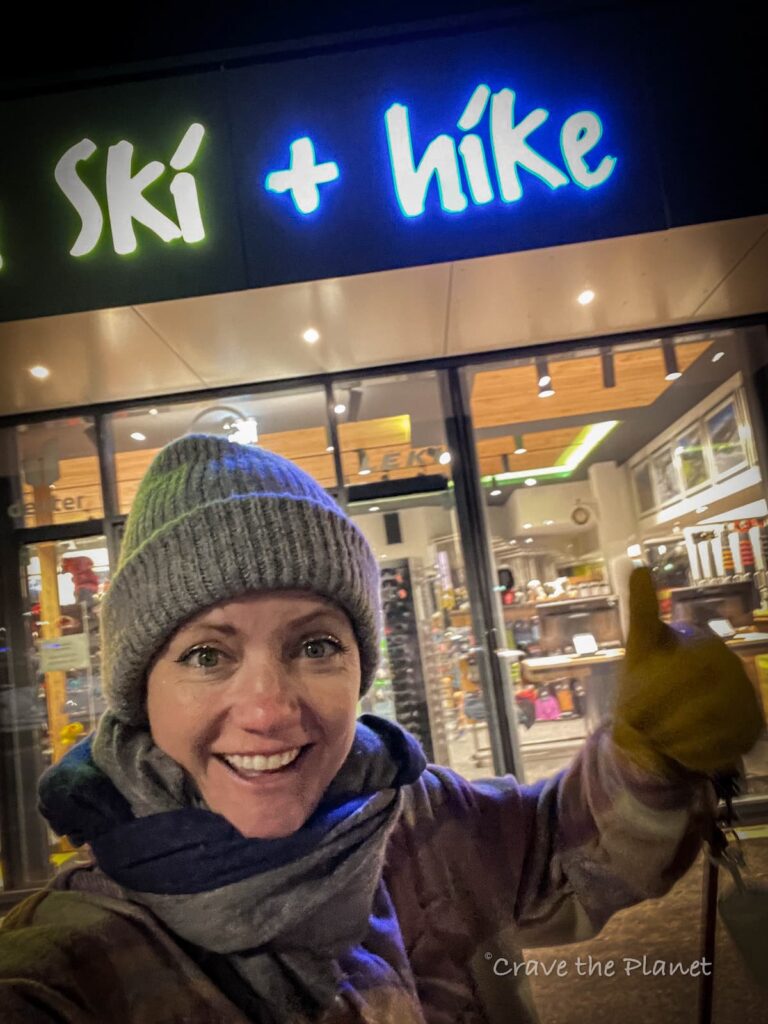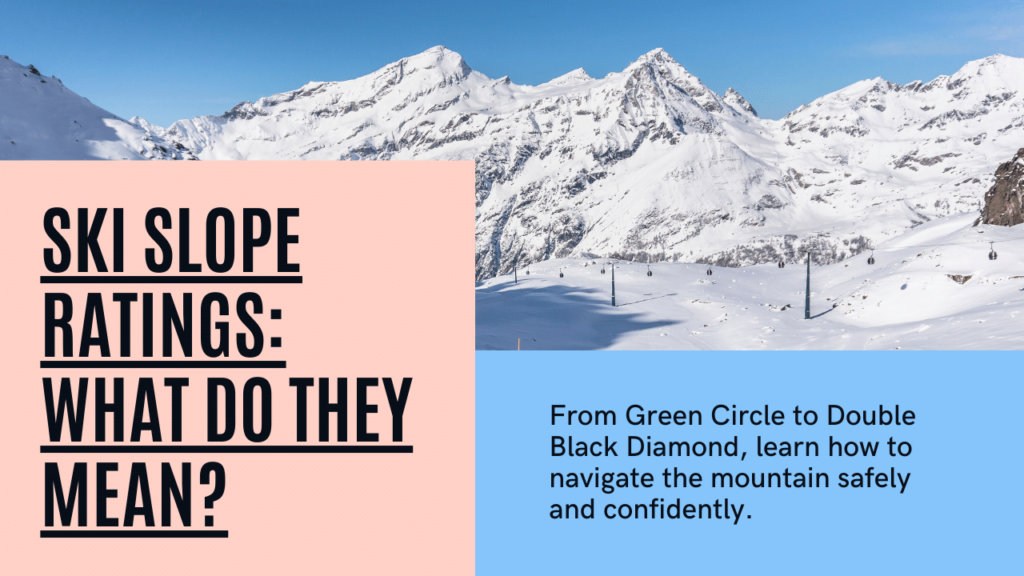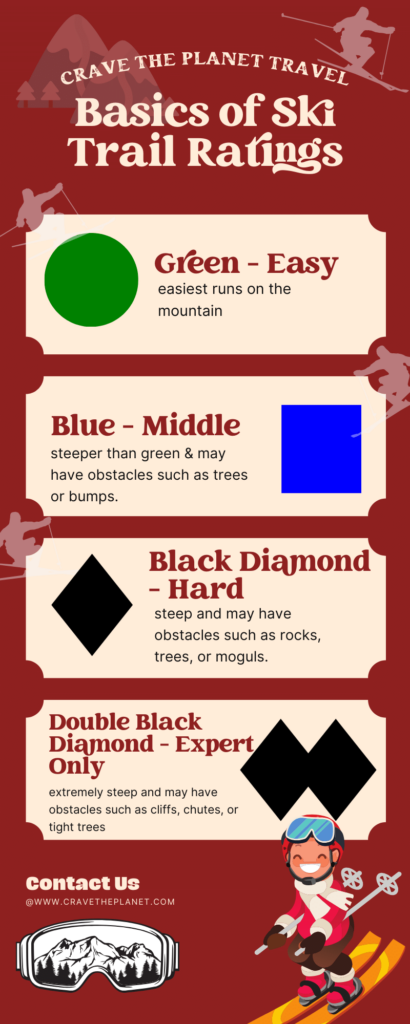Ski slope ratings are used to classify slopes based on their difficulty level, helping skiers choose the appropriate slope for their skills and experience – but it’s not always so clear cut.

I’ve skied in Asia, Europe and the East and West Coasts (a little in the middle but does that count?) of the USA and I can confidently tell you that I’m obsessed with ski slope ratings because I’m a mid-level skier and never want to become expert.

i.e. I don’t want to get caught somewhere scary.
Ski Slope Ratings Infographic

Ski Slope Ratings Key Takeaways
- Understanding ski slope ratings is essential for every skier to ensure their safety on the slopes.
- In USA Beginner level slopes are marked with green circles, intermediate level slopes with blue squares, and advanced level slopes with black diamonds.
- In Europe there’s a also “red” and “orange” to make it more confusing.
- Ski slope ratings can vary between ski resorts, so it’s important to check the ratings for each individual slope before skiing.
- While these ratings should be across the board, beware that sometimes they aren’t regulated perfectly.
❌ SO I NEED to know which runs I can enjoy and not end up taking off my skiis and sliding down on my butt.
And, yes. It’s different in Europe. They have reds and oranges that aren’t used in USA. They also have a lot of “off-piste” that is NOT backcountry skiing.
We always call it an “Austrian blue” meaning it’s really red (in Italy the exact same run would be classified as more advanced). Those people are born with zero fear (yes, I’m jealous).
Read until the end where I share the difference between Europe and USA ski slope ratings.
Quick Take Ski Slope Ratings:
Are the ratings legit? Only somewhat and it’s highly varied. Beginner level slopes are generally marked with green circles, intermediate level slopes with blue squares, and advanced level slopes with black diamonds.
So let’s be honest. You’re reading this because someone really good at skiing wants you to go and you’re not sure about any of this.
And you probably don’t want to get stuck at the top of a lift and scared to go down something too aggressive but you want to get off the bunny hill.
The ratings are based on several factors, including slope gradient, trail width, and the presence of obstacles such as trees and rocks. It’s important to note that ski slope ratings can vary between ski resorts, so it’s essential to check the ratings for each individual slope before skiing.
Ski Slope Ratings
When it comes to skiing, understanding ski slope ratings is essential. Ski slope ratings are used to indicate the difficulty of a ski run and help skiers choose a run that is appropriate for their skill level.
The rating system is typically used in North America and Europe, and while the rating systems may differ slightly between countries, the general principles are the same.
Rating System
The rating system for ski slopes is based on the steepness of the run, the width of the trail, the presence of obstacles, and the snow conditions. The rating system uses a series of symbols and colors to indicate the level of difficulty of a run. The most common rating system uses green circles, blue squares, black diamonds, and double black diamonds. Green circles indicate beginner runs, blue squares are intermediate runs, black diamonds are advanced runs, and double black diamonds are expert runs.
Ski Slope Ratings: Pros and Cons
- Ease of Communication
- Set Expectations of Difficulty
- Easy to Read Signs
- Highly Subjective
- Overconfidence Risk
- Changes with Time and Conditions
Ease Communication
Slope ratings provide an easy way for resorts to communicate difficulty levels to skiers of different abilities. Someone of any experience can understand at a glance what a green, blue, or black slope entails.
Set Expectations
Ratings help skiers set expectations for what they’ll encounter on different runs, as explained in the Peak Rankings article. Beginners know to avoid blacks and experts know greens won’t challenge them.
Subjectivity Issues
However, ratings rely on subjectivity and can vary between resorts. This means the challenges may not be consistent for runs with the same color.
Changes Over Time
Conditions like weather, grooming, and traffic can impact the real difficulty on a given day. A run rated blue may be harder or easier than normal.
Overconfidence Risk
Skiers familiar with one resort may get overconfident on similarly rated runs elsewhere. The actual terrain could be deceptively more challenging.
Beginner Level Slopes
If you’re new to skiing, then beginner level slopes are the perfect place to start. These slopes are designed for first-time skiers and are marked with green circle symbols on trail maps. In this section, we’ll cover everything you need to know about skiing on beginner slopes.
Green Circle Slopes
Green circle slopes are the easiest slopes on the mountain, and they’re perfect for beginner skiers. These slopes are marked with green circle symbols on trail maps and are typically wide and gently sloping. They’re also usually groomed regularly to provide a smooth surface for skiing.
Wide and Groomed Slopes
One of the best things about beginner slopes is that they’re usually wide and groomed. This means that there’s plenty of room for you to practice your turns and control your speed. The groomed surface also makes it easier to ski, as you won’t have to worry about skiing over bumps or uneven terrain.
Resort Facilities for Beginners
Many ski resorts have dedicated facilities for beginner skiers. These facilities often include magic carpets or beginner lifts, which are designed to make it easier for you to get up the mountain. They may also have separate beginner slopes, so you won’t have to worry about more advanced skiers whizzing past you.
Safety Measures for Beginners
Skiing can be a lot of fun, but it’s important to stay safe on the slopes. Ski resorts take safety seriously, and they have a number of measures in place to protect beginner skiers. Ski patrol is always on hand to help if you get into trouble, and many resorts have safety signs and markers on the slopes to keep you informed of any hazards.
Learning and Progression
The key to becoming a better skier is to keep learning and practicing. Beginner slopes are the perfect place to start, and you can work your way up to more advanced slopes as you improve. Ski schools are also available at many resorts, and they can help you learn the basics of skiing and progress to more advanced techniques.
Trail Map Symbols for Beginners
Trail maps can be confusing, especially if you’re new to skiing. Beginner slopes are marked with green circle symbols on trail maps, so be sure to look out for these symbols when planning your route.
Beginner Slopes in Different Regions
Beginner slopes can be found at ski resorts all over the world. North America, Europe, Japan, and Canada all have great beginner slopes, so you’re sure to find a resort that suits your needs.
Beginner Skiing Techniques
When skiing on beginner slopes, it’s important to focus on your balance and control. Try to keep your weight centered over your skis and use your edges to control your speed. Work on perfecting your turns and practice carving and parallel turns as you progress.
Hazards on Beginner Slopes
While beginner slopes are generally safe, there are still hazards to be aware of. Rocks, trees, and other obstacles can be dangerous if you’re not paying attention, so be sure to stay in control and keep an eye out for any hazards on the slopes.
Snowboarding on Beginner Slopes
If you’re interested in snowboarding, then beginner slopes are a great place to start. Many resorts have dedicated beginner terrain parks, which are designed specifically for snowboarders. Be sure to rent a snowboard and take a lesson to learn the basics before hitting the slopes.
Terrain Parks for Beginners
Terrain parks are areas of the mountain that are specifically designed for skiers and snowboarders to practice tricks and jumps. Many resorts have beginner terrain parks, which are perfect for first-time skiers and snowboarders.
First-time Skier Tips
If you’re skiing for the first time, then there are a few things you should keep in mind. Dress warmly and in layers, wear a helmet, and be sure to take lessons to learn the basics of skiing. Don’t be afraid to ask for help, and remember to take breaks when you need them.
Intermediate Level Slopes
As an intermediate skier, you’re ready to tackle more challenging terrain than the green circle slopes, but you’re not quite ready for the black diamond runs. Intermediate slopes are marked with blue squares in North America and Europe, and blue trails in Japan. These slopes offer a good mix of steepness, obstacles, and terrain features to keep you engaged and challenged.
Blue Square Slopes
Blue square slopes are the bread and butter of intermediate skiing. They offer a good mix of groomed runs, moguls, and varied terrain. These slopes are perfect for intermediate skiers who want to work on carving and parallel turns. Some blue square slopes may have steeper sections or more obstacles, so be sure to check the trail map before heading down.
Moguls and Bumps
Moguls and bumps are a common feature on intermediate slopes. These are mounds of snow that form naturally or are created by grooming machines. Skiing moguls is a great way to improve your balance and technique. Start by skiing around the bumps, then try to make short turns over them. As you get better, you can start linking turns and skiing faster.
Off-Piste Skiing for Intermediates
Off-piste skiing refers to skiing outside of marked trails. While it can be dangerous, it can also be a lot of fun. Many ski resorts offer guided off-piste tours for intermediate skiers. These tours take you to unmarked areas of the mountain where you can ski through powder and trees. Be sure to follow the guide’s instructions and never ski alone.
Intermediate Slopes in Different Regions
Intermediate slopes can vary depending on the region. In North America, intermediate slopes tend to be groomed and have a lot of terrain features. In Europe, intermediate slopes may be steeper and have more moguls. In Japan, intermediate slopes tend to be narrower and have more trees. Be sure to research the ski resort you’re visiting to get an idea of what to expect.
Intermediate Skiing Techniques
To ski intermediate slopes, you’ll need to master some basic techniques. Carving is an essential skill for intermediate skiers. This involves using the edges of your skis to make turns. Parallel turns are also important. This involves keeping your skis parallel to each other as you turn. Other techniques to work on include pole planting, weight distribution, and speed control.
Hazards on Intermediate Slopes
Intermediate slopes can have hazards such as rocks, trees, and steep drop-offs. Be sure to stay within the marked boundaries and follow the signs. If you’re skiing in a new area, take it slow and scout out the terrain before heading down. Always wear a helmet and other protective gear.
Snowboarding on Intermediate Slopes
Snowboarders can also enjoy intermediate slopes. Many ski resorts have terrain parks specifically designed for snowboarders. These parks have features such as jumps, rails, and boxes. Be sure to start small and work your way up to more challenging features.
Terrain Parks for Intermediates
Terrain parks are a great way to work on your freestyle skills. Many ski resorts have terrain parks specifically designed for intermediate skiers. These parks have features such as small jumps, boxes, and rails. Be sure to start small and work your way up to more challenging features.
Tips for Progressing from Intermediate to Advanced
If you’re ready to take your skiing to the next level, here are some tips to help you progress from intermediate to advanced:
- Ski with more experienced skiers
- Take lessons from a professional instructor
- Work on your technique and try new things
- Challenge yourself on more difficult terrain
- Ski in different regions to experience new types of terrain
- Practice, practice, practice!
Advanced Level Slopes
If you are an experienced skier looking for a challenge, advanced level slopes are the perfect choice for you. These slopes are designed for expert skiers who are comfortable with high speeds, steep gradients, and narrower trails. In this section, we will discuss the different types of advanced level slopes and what you can expect when skiing on them.
Black Diamond and Double Black Diamond Slopes
Black diamond slopes are the most common type of advanced slope. These runs are steeper and narrower than blue or green runs and require a higher level of skill to navigate. Double black diamond slopes are even more challenging, with steep gradients, tight turns, and obstacles like rocks and trees.
Steep and Narrow Slopes
Steep and narrow slopes require advanced skiing techniques like carving and parallel turns. These slopes are often found in North America, Europe, and Japan and are popular with expert skiers who are looking for a more challenging experience.
Ungroomed and Icy Conditions
Advanced skiers should be prepared for ungroomed and icy conditions when skiing on black diamond slopes. These conditions can make the slope more challenging, but also more exciting for experienced skiers.
Advanced Slopes in Different Regions
Different regions have their own unique types of advanced slopes. For example, Canadian resorts are known for their challenging terrain, while European resorts often have steeper slopes with narrower trails.
Advanced Skiing Techniques
Expert skiers should have a good understanding of advanced skiing techniques like carving, parallel turns, and mogul skiing. These techniques can help you navigate the challenging terrain of advanced slopes with ease.
Hazards on Advanced Slopes
Advanced slopes can be dangerous if you are not prepared for the hazards they present. Hazards like steepness, obstacles like rocks and trees, and cliffs can be challenging to navigate. It is important to always be aware of your surroundings and ski within your skill level.
Off-Piste Skiing for Advanced Skiers
Off-piste skiing is becoming more popular among expert skiers. Off-piste skiing involves skiing outside of marked trails and can be a more challenging experience for advanced skiers.
Snowboarding on Advanced Slopes
Snowboarders can also enjoy advanced level slopes, but should be prepared for the steeper gradients and narrower trails. Terrain parks with jumps and other obstacles are also popular with expert snowboarders.
Terrain Parks for Advanced Skiers
Terrain parks are designed for skiers and snowboarders who are looking for a more challenging experience. These parks often have jumps, rails, and other obstacles that require advanced skills to navigate.
Tips for Expert Skiers
If you are an expert skier, it is important to always ski within your skill level and be aware of your surroundings. Remember to stay in control and be prepared for the challenges that advanced level slopes present.
Youtube Ski Slope Ratings
Europe vs USA Ski Slope Ratings
Ski Trail Ratings USA
➡️ Read my upcoming article about ski trail ratings in Europe.
| Rating | Level | USA Description |
|---|---|---|
| Green Circle | Beginner | Green circle trails are the easiest runs on the mountain. They are typically wide, gentle, and have a very low gradient. These runs are perfect for those who are new to skiing or those who are looking for a leisurely ski. |
| Blue Square | Intermediate | Blue square trails are for intermediate skiers who are comfortable with basic turns and are looking for a bit more of a challenge. These runs are steeper than green circle runs and may have obstacles such as trees or bumps. |
| Black Diamond | Advanced | Black diamond trails are for advanced skiers who have mastered the basic techniques of skiing. These runs are steep and may have obstacles such as rocks, trees, or moguls. |
| Double Black Diamond | Expert | Double black diamond trails are for expert skiers who are looking for a serious challenge. These runs are extremely steep and may have obstacles such as cliffs, chutes, or tight trees. |
`
Green Circle – Beginner: Green circle trails are the easiest runs on the mountain. They are typically wide, gentle, and have a very low gradient. These runs are perfect for those who are new to skiing or those who are looking for a leisurely ski.
Blue Square – Intermediate: Blue square trails are for intermediate skiers who are comfortable with basic turns and are looking for a bit more of a challenge. These runs are steeper than green circle runs and may have obstacles such as trees or bumps.
Black Diamond – Advanced: Black diamond trails are for advanced skiers who have mastered the basic techniques of skiing. These runs are steep and may have obstacles such as rocks, trees, or moguls.
Double Black Diamond – Expert: Double black diamond trails are for expert skiers who are looking for a serious challenge. These runs are extremely steep and may have obstacles such as cliffs, chutes, or tight trees.
Ski Trail Ratings in Europe:
| Rating | Level of Difficulty | European Description |
|---|---|---|
| Green Circle | Beginner | The easiest slopes suitable for beginners just learning how to ski or snowboard. Gentle slopes with little to no incline. |
| Blue Square | Intermediate | Groomed trails suitable for intermediate skiers and snowboarders who can stop and turn. May have steeper inclines and narrower trails than greens. |
| Red Square | Advanced | Challenging terrain featuring steep slopes, moguls, trees, and other difficult elements. Requires strong control of speed and technique. |
| Black Diamond | Expert | The most difficult slopes, often very steep, narrow, and with extreme terrain like cliffs or chutes. Only for highly skilled skiers and snowboarders with excellent control. |
| Orange | At Your Own Risk | Some resorts have orange runs which is “off-piste” and not groomed, but it is not backcountry. |
Green Circle (Beginner): The easiest slopes suitable for beginners just learning how to ski or snowboard. Green circles have gentle slopes with little to no incline.
Blue Square (Intermediate): Slopes rated blue square are groomed trails suitable for intermediate skiers and snowboarders who have learned how to stop and turn on easier green runs. Blue squares may have steeper inclines and narrower trails than greens.
Red Square (Advanced): Red square rated runs are meant for experienced skiers and snowboarders. They feature steep slopes, moguls, trees, and other challenging terrain elements. Strong control of speed and technique is required on reds.
Black Diamond (Expert): Black diamond runs are the most difficult slopes in a resort, often very steep, narrow, and featuring extreme terrain like cliffs or chutes. Only highly skilled skiers and snowboarders should attempt black diamond runs, which require excellent control and ability to handle all conditions.
Some resorts, like in France UK and Andorra, also include Green Circles to further differentiate very gentle beginner slopes from easier blue squares. But across Europe, the standardized system is typically green, blue, red, and black to indicate difficulty from easiest to most advanced.
Frequently Asked Questions
What are the different ski slope ratings?
Ski slope ratings are used to indicate the difficulty level of a particular ski run. The rating system used in the United States is as follows:
- Green circles: Easy
- Blue squares: Intermediate
- Black diamonds: Difficult
- Double black diamonds: Expert
What is the steepest ski resort in the US?
The steepest ski resort in the US is Silverton Mountain in Colorado. It has an average slope angle of 38 degrees, which is steeper than most ski resorts in the country.
What is a black diamond ski slope?
A black diamond ski slope is a ski run that is considered to be difficult. It is meant for experienced skiers who are comfortable skiing on steeper and more challenging terrain.
What is the difference between a blue and a green ski slope?
A blue ski slope is more difficult than a green ski slope. Blue slopes are meant for intermediate skiers who are comfortable skiing on slightly steeper terrain. Green slopes, on the other hand, are for beginners who are just starting to learn how to ski.
What do the numbers on ski slopes mean?
The numbers on ski slopes indicate the steepness of the slope. The higher the number, the steeper the slope. For example, a slope with a number of 20 would be steeper than a slope with a number of 10.
What are the grades for steep skiing slopes?
The grades for steep skiing slopes are as follows:
- Grade I: 25-30 degrees
- Grade II: 30-35 degrees
- Grade III: 35-40 degrees
- Grade IV: 40-45 degrees
- Grade V: 45+ degrees
These grades are used to indicate the steepness of backcountry skiing terrain. It is important to note that skiing in backcountry terrain can be dangerous and should only be attempted by experienced skiers with proper training and equipment.
We hope this guide explaining ski slope ratings has given you the proper information to plan your next winter adventure.
More Skiing Guides

Author profile: Morgan Fielder is a Doctor of Physical Therapy and passionate hiker who believes in exploring the world on foot with good food. Follow her journey as she shares science-based hiking tips and advocates for sustainable tourism.
